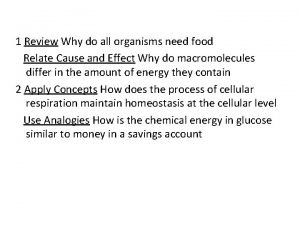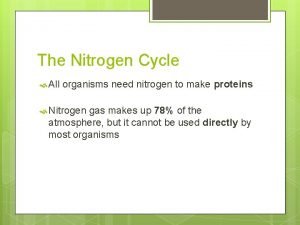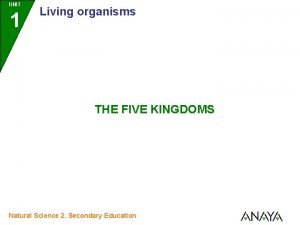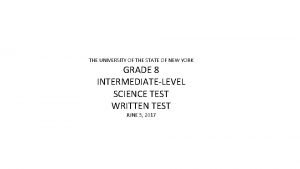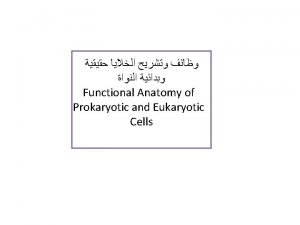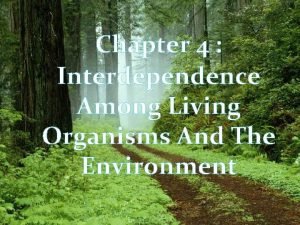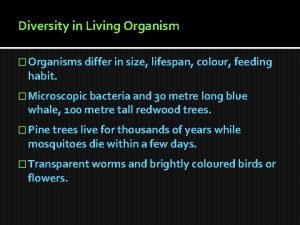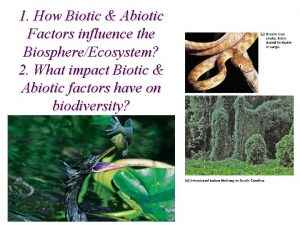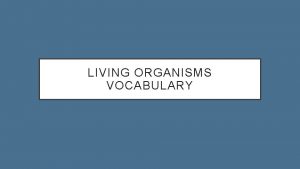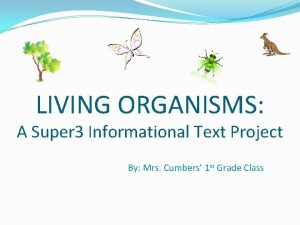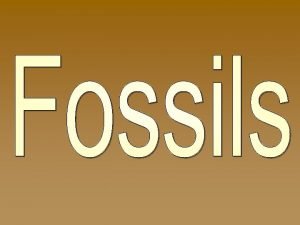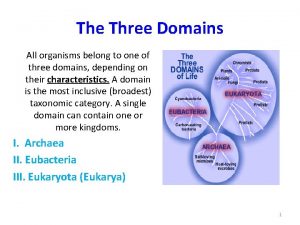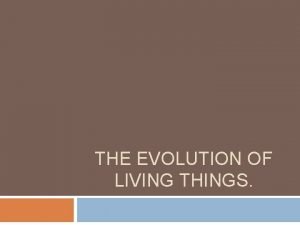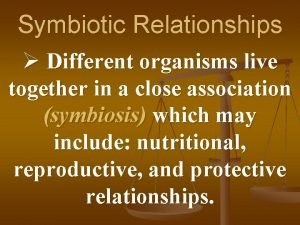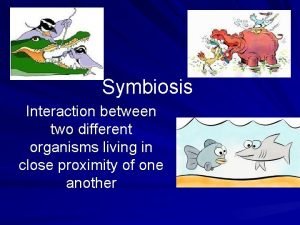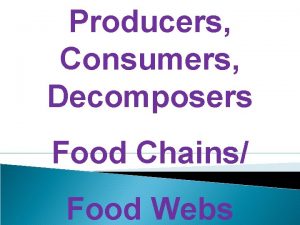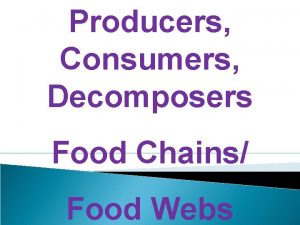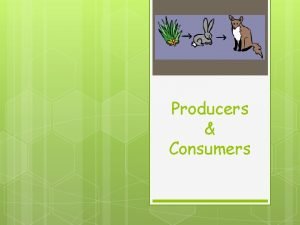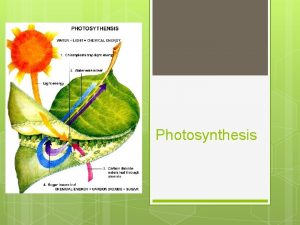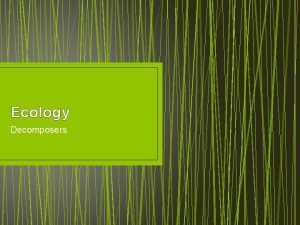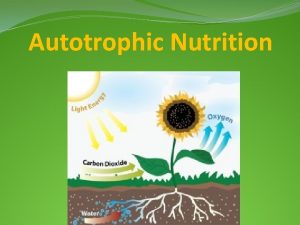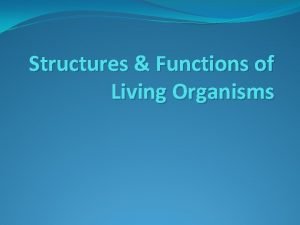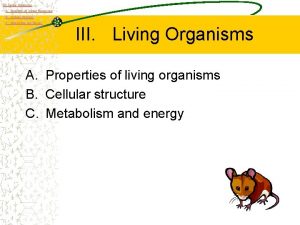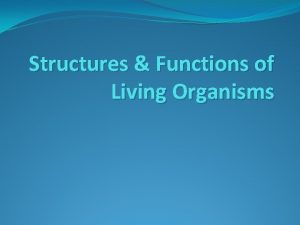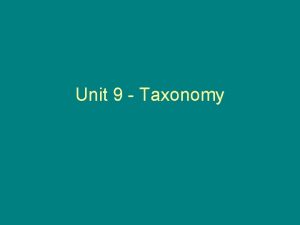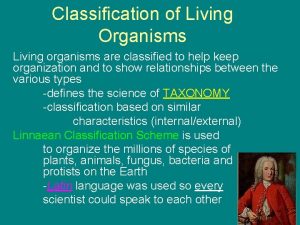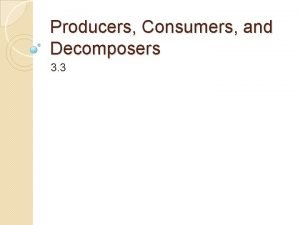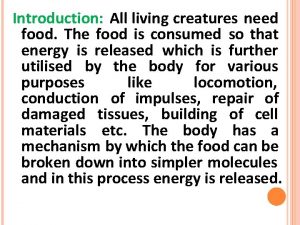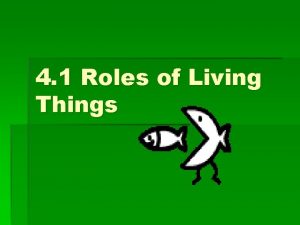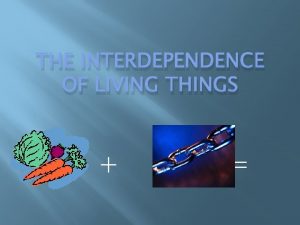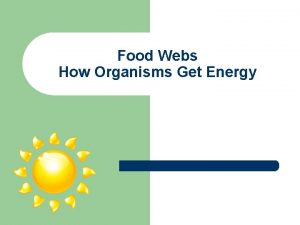ChapterPhotosynthesis PLANTSSELF FOOD PRODUCERS All living organisms need










![LIGHT-INDEPENDENT(DARK) PHASE[also called Biosynthetic phase] The new term light independent phase The old term LIGHT-INDEPENDENT(DARK) PHASE[also called Biosynthetic phase] The new term light independent phase The old term](https://slidetodoc.com/presentation_image_h2/390c97f985f23a5b01c08703fa312b23/image-11.jpg)












- Slides: 23

Chapter-Photosynthesis

PLANTS-SELF FOOD PRODUCERS All living organisms need food. Animals obtain food from plants but plants prepare it for themselves by the process of photosynthesis. WHAT IS PHOTOSYNTHESIS ? Photosynthesis is an important activity of all green plants which are able to synthesise food from carbon dioxide and water in the presence of chlorophyll and light energy. The essential chemical steps in this process are the same in all green plants. Photosynthesis is the anabolic process by which living plant Cells, containing chlorophyll, produce food substances (glucose and starch), from carbon dioxide and water, by using light energy. Plants release oxygen as a byproduct during photosynthesis.

Importance of Photosynthesis 1. Food for all: Photosynthesis is ultimately the source of energy and food for all living beings directly for plants and indirectly for animals and humans who eat the plants or the plant-eating animals. 2. Oxygen to breathe in: Photosynthesis is the only biological process which releases oxygen into the atmosphere. Oxygen supports all life on earth. No living being can remain alive without oxygen.

CHLOROPHYLL-THE VITAL PLANT PIGMENT Chlorophyll (chloro : green, phyll : leaf) is the green colouring matter found in plants. It is contained in microscopic cell organelles called chloroplasts. Chloroplasts are minute oval bodies bounded by a double membrane, and their interior contains closely packed flattened sacs (thylakoids) arranged in piles (grana) lying in a colourless ground substance called stroma. Ordinarily, there may be 40 -50 chloroplasts in a cell. The pigment chlorophyll is contained in the walls of thylakoids. It is a highly complex substance, composed of carbon, hydrogen, oxygen, nitrogen and magnesium. Chloroplasts are mainly contained in the mesophyll cells located between the upper epidermis (in palisade cells and spongy cells) of leaves. These are also found in the guard cells of stomata and in the outer layers of young green stems. There may be more than 500, 000 chloroplasts per sq. mm. of leaf surface. You will be surprised to know that there are nine types of chlorophyll. Two out of these, chlorophyll-a and chlorophyll-b, are best known and most abundant. Chlorophylls absorb light at both ends of the visible spectrum (BLUE and RED light, and reflect away the green light. That is why, chlorophyll appears green. ) The absorbed blue and red lights are most effective for photosynthesis.

Too much light destroys chlorophyll Chlorophyll is highly may sensitive to light, so too much light may destroy it. However, the formation of chlorophyll itself depends on the exposure of the plant to light. The grass growing in the shade under a stone turns yellowish due to the non-formation of new chlorophyll and due to the disintegration of the older one in the absence of light.

REGULATION OF STOMATAL OPENING FOR LETTING IN CARBON DIOXIDE Stomata are minute openings occurring in large numbers on the lower surface of a leaf. The main function of the stomata is to let in Carbon Dioxide from the atmosphere for photosynthesis. When stomata are not in use for photosynthesis, when it is dark, they tend to close their openings so that water loss is minimised from the leaves through transpiration. When there is light, as after sunrise, they reopen to allow Carbon Dioxide to diffuse in. Transpiration occurs along with photosynthesis. Due to this process, one can say that transpiration is the price which the plant pays for photosynthesis. The closing and opening of the stomata are on account of the movement of water in and out of the guard cells. They have a thick inner wall facing the opening and a thin outer wall on the opposite side their cytoplasm contains chloroplast. Opening and Closing of Stomata There are two theories about the opening and closing of stomata. 1. Potassium ion concentration theory (recent) 2. Sugar concentration theory (old)

Potassium ion concentration theory: According to the recent potassium ion concentration theory, the stomatal opening and closing depend on the generation of potassium ion gradient. During daytime, the chloroplasts in the guard cells photosynthesis which leads to the production of ATP. This ATP is used to actively pump the potassium ions of the adjacent cells into the guard cells. Increased Potassium concentration in the guard cells makes them hypertonic, so, more water from the adjacent cells is drawn in and the cells become more turgid and they move outwards to open out the stomatal pore. Reverse happens at night. The potassium ions leak out thus reducing the turgor of guard cells and the stomatal pore closes. Sugar concentration theory: According to the old sugar concentration theory, during daytime, the guard cells begin photosynthesis and the sugar (glucose) produce during the process increases the osmotic pressure which draws in water from the adjoining cells due to endosmosis. Hence, the guard cells become turgid and bulge outwards due to their thin outer wall, thus widening the stomatal opening lying in between. As the stomata open, the diffusion of gases in and out begins for fulfilling the need for photosynthesis and for allowing transpiration. Closing of the stomata : If for any reason, the water content of the leaf is falling short, the water is drawn out of the guard cells due to exosmosis making them flaccid. As a result, their inner thick walls straighten to close the stomata.

PROCESS OF PHOTOSYNTHESIS Mesophyll cells (both palisade and spongy) in a leaf are the principle centres of this activity. During daytime, when sunlight falls on the leaf, the light energy is trapped by the chlorophyll of the upper layers of mesophyll, especially the palisade cells. This energy is utilised in chemical process involved in the manufacture of food, where the raw materials used are carbon dioxide and water. • Carbon dioxide from the atmosphere enters the leaf by diffusion down a concentration gradient (higher concentration outside the leaf, and less concentration inside) through the stomata. • Water from the soil is taken up by the roots, sent up through the stem and finally to the leaves where it is distributed in the mesophyll tissue. The chemical equations to present this process is as follows : The glucose molecules is a simple sugar readily soluble in water. The 6 molecules of water liberated at the end of the process are those that are re-foemed during a chain of reaction and not out of the original ones

TWO MAIN PHASES OF PHOTOSYNTHESIS (A) LIGHT-DEPENDENT PHASE (PHOTOCHEMICAL PHASE) In this phase, light plays the key role. A series of chemical reaction occur in very quick succession, initiated by light and therefore the phase is called the photochemical phase. The light reaction takes place in thylakoids (containing chlorophyll) of the chloroplasts. The light reaction (photochemical phase)occurs in two main steps. Step I. Activation of chlorophyll. The chlorophyll on exposure to light energy becomes activated by absorbing photons (photon is the smallest unit of light energy). Step II. Splitting of water. The absorbed energy is used in splitting the water molecule into its two components (Hydrogen and Oxygen) and releasing electrons. The reaction is known as photolysis, which means splitting by light (photo = light, lysis = breaking). Photolysis is defined as the splitting of water molecules into hydrogen ions and oxygen in the presence of light and grana.

End result of the products of photolysis 1. The hydrogen ions are picked up by a compound NADP (Nicotinamide adenine dinucleotide phosphate) to form NADPh. 2. 3. The electrons (e-) are used in converting ADP (adenosine triphosphate) by adding one phosphate group P (inorganic phosphate). [This process is called phosphorylation (addition of phosphate) and since the energy used in the process comes from light (photons), the process is termed as photophosphorylation].
![LIGHTINDEPENDENTDARK PHASEalso called Biosynthetic phase The new term light independent phase The old term LIGHT-INDEPENDENT(DARK) PHASE[also called Biosynthetic phase] The new term light independent phase The old term](https://slidetodoc.com/presentation_image_h2/390c97f985f23a5b01c08703fa312b23/image-11.jpg)
LIGHT-INDEPENDENT(DARK) PHASE[also called Biosynthetic phase] The new term light independent phase The old term “dark phase” did not mean that it occurs when it is dark at night. It only meant that the reactions are not dependent on light. that is why, it is now better to call it “light independent phase” The reactions in this phase do not require light energy, and occur simultaneously with the light reaction (time gap between the two being less than even one-thousandth of a second). Conversion of glucose into starch and other chemicals: Most green plants convert glucose into starch as soon as it is formed during photosynthesis. Several glucose molecules are transformed to produce one molecule of starch; this process is called polymerisation. Some plants change glucose to sucrose (cane sugar, which chemically is called disaccharide or double sugar), or some into oils, etc.

ADAPTATIONS IN LEAF TO PEFORM PHOTOSYNTHESIS 1. Large surface area for maximum light absorption. (Narrowing of leaves in certain plants is to minimise transpiration in order to conserve water, as in oleander and pine). 2. Leaf arrangement at the right angle to the light source to obtain maximum light. 3. Cuticle and upper epidermis are transparent and water proof to allow light to enter freely. 4. Numerous stomata allow rapid exchange of gases (oxygen and carbon dioxide). 5. The thinness of leaves reduces the distance between cells facilitating rapid transport. 6. The chloroplasts are concentrated in the upper layers of the leaf to obtain light energy quickly. 7. Extensive vein system for rapid transport to and from the mesophyll cells.

END RESULT OF THE PRODUCTS OF PHOTOSYNTHESIS There are three end-products of photosynthesis: I. Glucose : The simple sugar glucose is used in four different ways as required by the plant: 1. Immediately consumed by the plant cells 2. Stored in the form of insoluble starch 3. Converted into sucrose 4. Used in synthesising fats, proteins, etc. II. Water : The water produced in the process may be re-utilized in the continuance of photosynthesis. III. Oxygen : Some of the oxygen may be used in respiration in the leaf cells (the phenomenon is called photorespiration), but the major portion of it is not required and it diffuses out into the atmosphere through the stomata. In a sense, even this oxygen is not a waste, because all organisms require it for their existence including the plants which require it at night.

FACTORS AFFECTING PHOTOSYNTHESIS A. EXTERNAL FACTORS 1. Light intensity and Carbon dioxide concentration One would easily think that the rate of photosynthesis will increase with light intensity. To some extent, it is true. Photosynthesis increase with the light intensity up to a certain limit only, and then it gets stabilised at the point S’ (0. 02% Carbon dioxide). But if, at this point, the photosynthesis also increase further and again gets stabilised at a point S” = (0. 05% Carbon dioxide) for the two factors together. 2. Temperature With the rise in temperature, the rate of photosynthesis rises. This rise occurs up to the optimum temperature of 35 degree C (maximum suitable temperature when the photosynthesis occurs best) after which the rate falls and stops above 40 degree C. at this uppermost limit, the enzymes are destroyed. A rise of 10 degree C to the optimum temperature (35 degree C) doubles the rate of photosynthesis. For example, a rise from 20 degree C to 30 degree C, or 22 degree C to 32 degree C, or 25 degree C to 35 degree C, doubles the rate of photosynthesis. 3. Water Content The scarcity of water due to reduced absorption from the soil or due to an excessive loss through transpirartion reduces the rate of photosynthesis by decreasing diffusive capacity (carbon dioxide intake) due to the closure of stomata. Only 1% of water absorbed by the root is utilised in photosynthesis.

INTERNAL FACTORS I. Chlorophyll – Nutritional deficiencies of minerals cause loss of chlorophyll, and hence the drop in trapping solar energy. II. Protoplasm – Dehydration of protoplasm for some reason reduces the rate of photosynthesis. Similarly, the accumulation of carbohydrates (sugar and starch) also reduces the rate of photosynthesis. III. Structure of leaf – The thickness of cuticle, the distribution of stomata and the size of the leaf influence the amount of light and the amount of carbon dioxide entering the leaf.

EXPERIMENTS ON PHOTOSYNTHESIS A number of experiments can be performed for proving the various conditions and requirements necessary for photosynthesis. De-starching (Removal of starch) : A plant used for experiments on photosynthesis should initially be placed in the dark for 24 to 48 hours to de-starch the leaves. During this period, all the starch will be removed from the leaves and stored in the storage organs. The leaves will not show the presence of starch. A de-starched plant is one whose leaves are free from starch. To test a leaf for starch (Iodine test). • Dip the leaf in boiling water for a minute to kill the cells. • Boil the leaf in methylated spirit over a water bath till it becomes pale-white due to the removal of chlorophyll. The leaf now becomes hard and brittle. • Place it again in hot water to soften it. • Spread the leaf in a dish and pour iodine solution on it. The presence of starch will be indicated by a blueblack colour. A leaf without starch will show brown colouration.

Experiment 1: To show that chlorophyll is necessary for photosynthesis Take a plant with variegated leaves having some green and some non-green areas. Examples : Coleus, Geranium and Croton. • De-starch the leaves by keeping the plant in a dark room for a few days. • Place the plant in the sun. • After a few hours, pluck one leaf. • Make its outline on paper and mark the green and non-green areas on the outline. • Test the leaf for starch. Only the green parts • Of the leaf turn bluish, showing the presence of starch.

Experiment 2 : To show that sunlight is necessary for photosynthesis. • Take a plant with de-starched leaves • Cover one of its leaves with black paper on which a design is cut. • Place this plant in the sun. • After a few hours, test the leaf which is covered by black paper for the presence of starch. It will be observed that only the parts of the leaf, which could get light through the cut out design as well as those that were left uncovered by the paper, turn blue-black, showing the presence of starch.

Experiment 3: To show that carbon dioxide is necessary for photosynthesis • Take a plant with de-starched leaves. • Insert a part (half) of one of its leaves (through a split cork) into a conical flask containing potassium hydroxide. (Potassium hydroxide absorbs carbon dioxide). • Leave the plant in sunlight. • After a few hours, test the leaf for starch. ` The part of the leaf which was exposed to the atmosphere air becomes blue-black, and the part of the leaf inside the flask containing potassium hydroxide does not become blue-black, showing that part of the leaf outside the flask becomes the control experiment. Note : The same experiment can be modified. Half of the leaf outside the bottle will show the presence of starch while the other half will not

Experiment 4: To show that oxygen is produced during photosynthesis • Place some water plants (Elodea and Hydrilla) in a beaker containing pond water and cover them by a shortstemmed funnel. • Invert a test-tube full of water over the stem of the funnel. (Ensure that the level of water in the beaker is above the level of stem of the inverted funnel). • Place the apparatus in the sun for a few hours. Bubbles of the gas will collect in the test-tube. • Test the gas in the test-tube. A glowing splinter burst into flame which shows the presence of oxygen.

IMPORTANCE OF PHOTOSYNTHESIS Photosynthesis supports all life on earth. If there were no green plants, all life on the earth would come to an end. Provides food : All animals, including humans, ultimately depend on plants for food. A herbivore (planteater) consumes the plant parts directly, while a carnivore (flesh-eater) eats flesh of an animal which in turn was a herbivore. This chain of food-dependence is called the food chain. The food chain may have a number of intervening stages but the starting point is always a plant (producer) which produces its own food through photosynthesis. You can imagine several food chains, for example: Corn->Rat->Snake->Hawk Grass->Grasshopper->Lizard->Kite Grass->Rabbit->Tiger Grass->Insects->Frog->Snake->Peacock Wheat->Man->Mosquito Non-green plants such as fungi and bacteria obtain their nourishment from decaying organi matter intheir environment. This matter comes from dead animals and plants, which in their own turn were dependent on photosynthesis.

Provides oxygen : The life-supporting gas oxygen, is present in the atmosphere in a free state only because of photosynthesis. Scientists strongly believe that about 2 billion years ago, when there was no life on the earth in any form, there was no free oxygen in the atmosphere. Appearance of green plants set the stage for the animals to appear. Almost all organisms need oxygen for respiration.

CARBON CYCLE The carbon cycle is a series of chemical reactions in which carbon as a chemical element (in carbon dioxide) is removed from the air, used by living organisms in their body processes and is finally returned to the air. The essential steps in the carbon cycle are as follows : i. Photosynthesis : Green plants (producers use carbon dioxide of the air to produce carbohydrates (sugar, starch, etc. ). ii. Food chains : Through food chains, the food (containing carbon in the carbohydrates and other products) passes on from plants to animals (consumers). Carbon is an essential element of all body tissue of both plants and animals. iii. Respiration : All plants and animals, respire by oxidising carbohydrates in their cells to produce energy and give out carbon dioxide into the atmosphere. iv. Decay : the dead remains of plants and animals are consumed by bacteria and fungi (decomposers), and in the process, they break down the organic matter, releasing carbon dioxide back into the atmosphere. v. Combustion (burning) : when a fuel such as wood or a fossil fuel like coal, petroleum or natural gas, is brunt, the carbon contained in it is oxidised to carbon dioxide, which is given back into the atmosphere. All the fuels named above originally come from living organisms. vi. Heating limestone : a certain amount of carbon dioxide is released durning heating or burning of limestone in lime kilns.
 Why do organisms need food
Why do organisms need food Venn diagram living and nonliving things
Venn diagram living and nonliving things Why do organisms need nitrogen?
Why do organisms need nitrogen? The smallest living unit within the human body is
The smallest living unit within the human body is Organisms that are producers
Organisms that are producers Protective food
Protective food Competitive interaction
Competitive interaction Unicellular and multicellular
Unicellular and multicellular Kingdoms of living things
Kingdoms of living things Three living organisms
Three living organisms Are all living things based on the metric system
Are all living things based on the metric system Modern classification of living organisms
Modern classification of living organisms Types of living organisms
Types of living organisms Planaria, liverfluke, tapeworm, ascaris *
Planaria, liverfluke, tapeworm, ascaris * Living organisms and their surroundings
Living organisms and their surroundings Two different organisms living together
Two different organisms living together 6 kingdoms
6 kingdoms What is the smallest unit of living organisms
What is the smallest unit of living organisms Living organisms
Living organisms Different types of fossil
Different types of fossil Three domains of living organisms
Three domains of living organisms Similar
Similar Two different organisms living together
Two different organisms living together Close interaction between two different organisms
Close interaction between two different organisms
